check engine AUDI A6 2013 Owner's Guide
[x] Cancel search | Manufacturer: AUDI, Model Year: 2013, Model line: A6, Model: AUDI A6 2013Pages: 306, PDF Size: 76.92 MB
Page 266 of 306
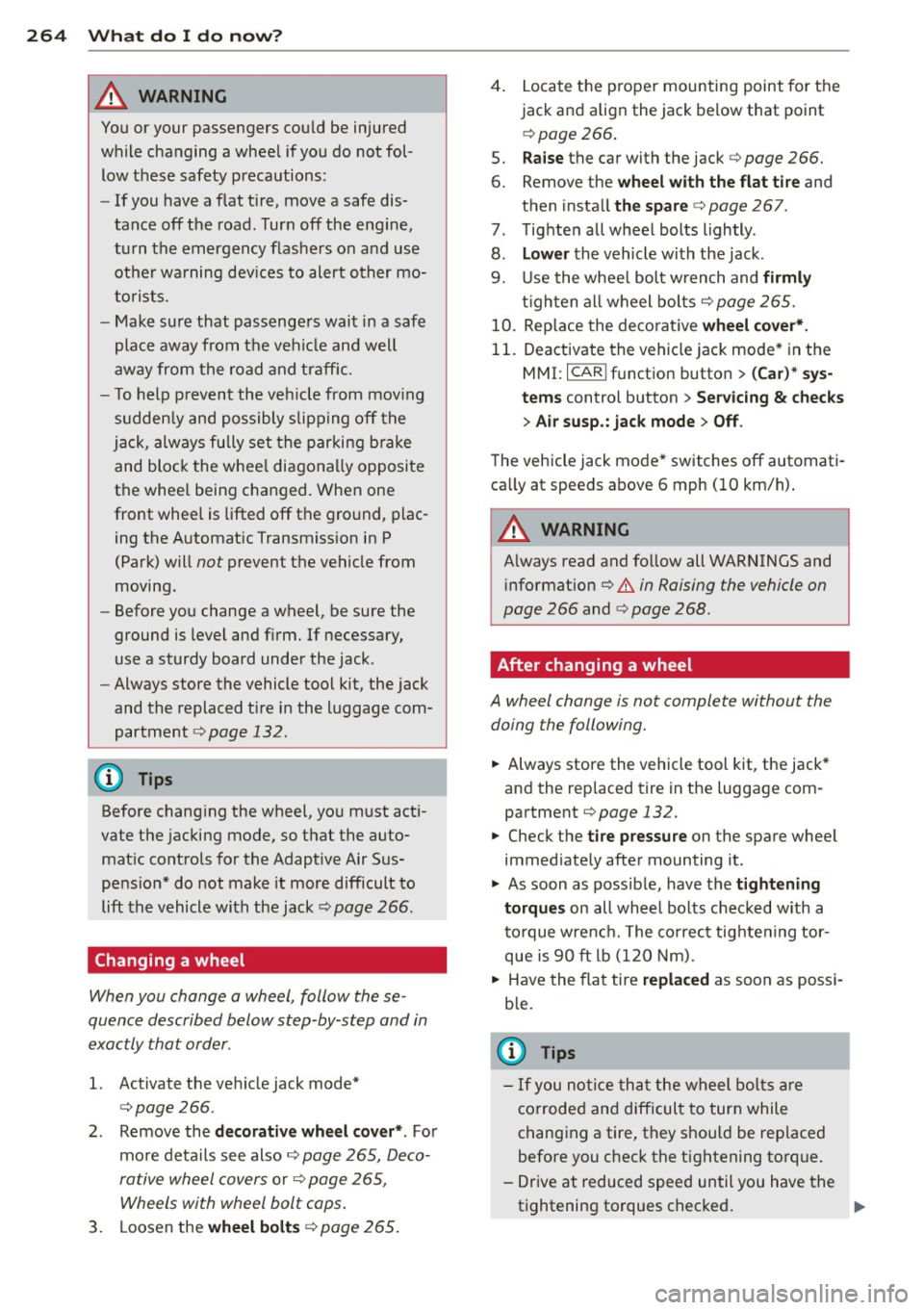
264 What do I do now?
&_ WARNING
You or your passengers could be injured
while changing a wheel if yo u do n ot fol
low t hese safety precautions:
- If you have a flat t ire, move a safe dis
tance
off the road. Turn off the engine,
turn the emergency flashers on and use other warning dev ices to alert other mo
torists.
- Make sure that passengers wait in a safe
place away from the vehicle and well
away from the road and traff ic.
- T o help p revent the veh icle from mov ing
sudden ly and possibly slipping off the
ja ck, always fully set the parking b rake
and bloc k the whee l diagona lly opposite
the whee l being changed. When one
front whee l is lifted off the gro und, plac
ing the Automat ic Transmiss ion in P
(Park) will
not prevent the vehicle from
moving.
- Before you change a wheel, be sure the
ground is level and firm. If necessary,
use a sturdy board under the jack.
- Always store the vehicle tool kit, the jack
and the replaced t ire i n the luggage com
partment
¢ page 132.
Before chang ing the wheel, yo u m ust acti
vate the jacking mode, so that the auto mat ic cont rols for the Adaptive Air S us
pens ion* do not make it more difficult to
lift the vehicle with the jack
c> page 266.
Changing a wheel
When you change a wheel, follow these
quence described below step-by-step and in
exactly that order .
1. Activate the vehicle jack mode*
~page 266.
-
2. Remove the decorative wheel cov er* . For
mo re details see also ¢
page 265, Deco
rative wheel covers
or c> page 265,
Wheels with wheel bolt caps.
3 . L oosen the wheel bolts¢ page 265.
4. Locate the proper mounting point for the
jack and alig n the jack below that point
¢ page 266 .
5.
Raise the car with the jack¢ page 266.
6. Remove the wheel with the flat tire and
then insta ll
the s pare ¢page 267.
7. Tighten all whee l bolts lightly.
8 . Lower the vehicle with the jack .
9. Use the wheel bolt wrench and firmly
t igh ten al l w heel bo lts¢ page 265.
10. Rep lace the decorat ive wh eel co ver* .
11. Deactivate the vehicle jack mode* in the
MMI:
ICARI f u nction button > (Car )* sys
tems
control button > Se rvicing & chec ks
> A ir susp .: jac k mode > Off .
The vehicle jack mode * switches off automati
ca lly at speeds above
6 mph (1 0 km/h) .
&_ WARNING ,.__
Always read and follow all WARNINGS and
i nformat ion¢ &.
in Raising the vehicle on
page 266
and c> page 268.
After changing a wheel
A wheel change is not complete without the doing the following.
.,. Always store the vehicle tool kit, the jack *
and the rep laced tire in the luggage com
partment
¢ page 132.
.,. Check t he ti re pressu re on the spare whee l
immed iate ly after mounting it .
.,. As soon as possib le, have the
tightening
torques
on all whee l bolts checked with a
t o rque wrenc h. The co rrect tighte ning tor
que is 90 ft lb (120 Nm).
.,. Have the flat tire
replaced as soon as possi
b le.
(D Tips
- If you not ice th at the wheel bo lts a re
co rroded and difficult to turn while
changing a tire, they should be rep laced
before you check the tightening torque.
- Drive at reduced speed until you have the
tightening torques checked .
ll-
Page 276 of 306
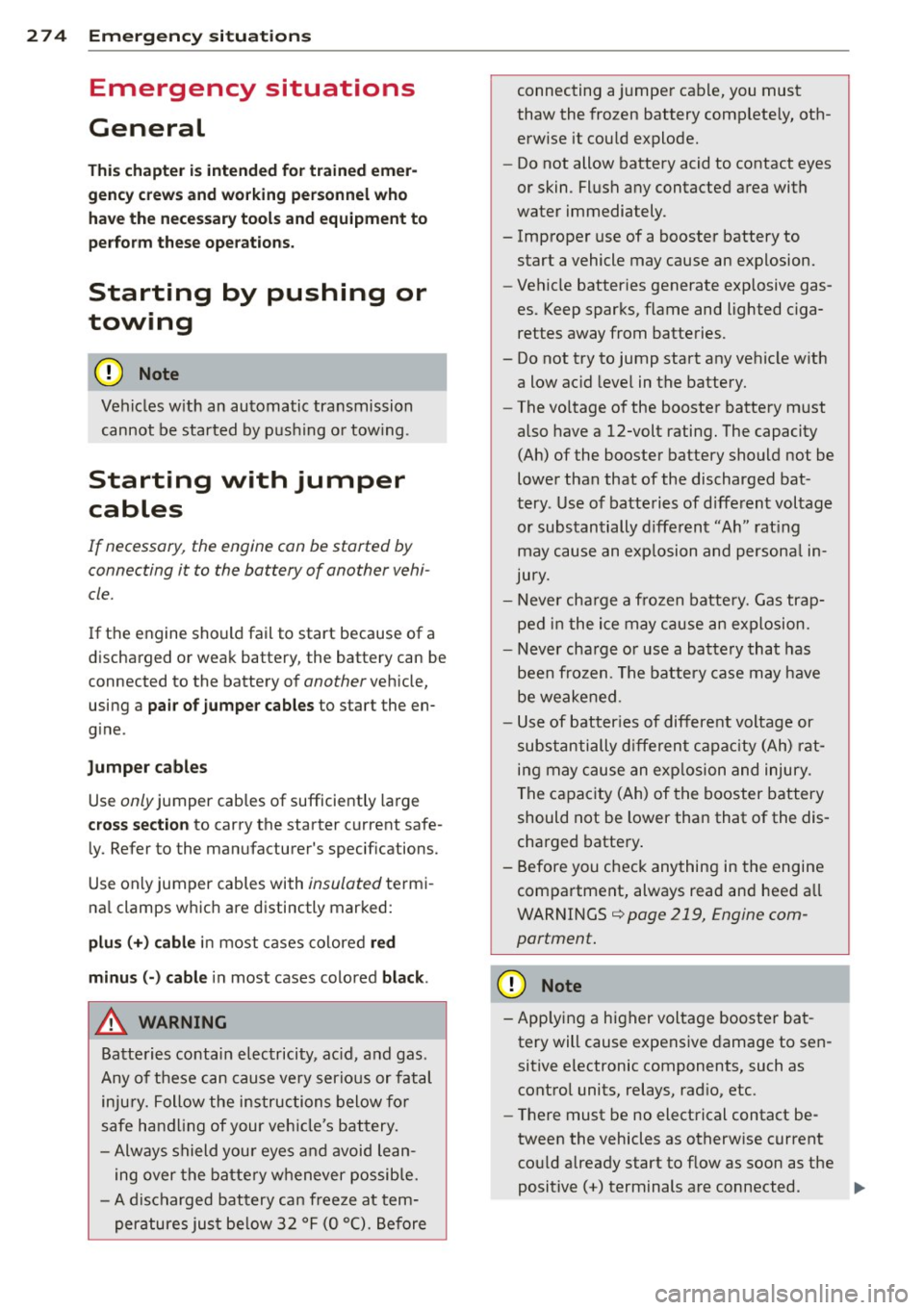
2 7 4 Emergency situations
Emergency situations
General
This chapter is intended for trained emer
gency crews and working personnel who
have the necessary tools and equipment to
perform these ope rations.
Starting by pushing or
towing
Q;) Note
Vehicles w ith an automatic transmission
cannot be started by pus hing o r tow ing.
Starting with jumper
cables
If necessary, the engine can be started by
connecting it to the battery of another vehi
cle.
If the engine should fail to start because of a
discharged or weak battery, the battery can be
connected to the battery of
another veh icle,
using a
pair of jumpe r cables to start the en
g ine .
Jumper cables
Use only jumper cables of sufficiently large
cross section to carry the starter current safe
ly. Refer to the manufacturer's specif ications.
Use only jumper cables with
insulated termi
na l clamps which are distinctly marked:
plus(+) cable in most cases colored red
minu s(-) cable
in most cases colored black .
A WARNING
Batteries contain electricity, acid, and gas.
Any of these can cause very serious or fatal
inju ry. Follow the instructions below for
safe handling of your veh icle's battery.
- Always shield you r eyes and avoid lean
ing over the battery whenever possible.
- A discharged battery can freeze at tem
peratures just be low 32 °F (0 °C). Before connecting a
jumper cable, you must
thaw the frozen battery complete ly, oth
erwise it could explode.
- Do not allow battery acid to contact eyes
or skin . Flush any contacted area with
water immediately .
- Improper use of a booster battery to start a vehicle may cause an explosion.
- Vehicle batteries generate explosive gas
es. Keep sparks, flame and lighted ciga
rettes away from batteries.
- Do not try to jump start any vehicle with a low acid level in the battery.
- The vo ltage of the booster battery must
also have a 12-volt rating. The capacity
(Ah) of the booster battery should not be
lower than that of the discharged bat
tery . Use of batteries of d ifferent voltage
or substantially different "Ah" rating
may cause an exp losion and personal in
jury.
- Never charge a frozen batte ry. Gas trap
ped in the ice may cause an explosion.
- Never charge or use a battery that has
been frozen. The battery case may have
be weakened.
- Use of batter ies of different voltage or
substantially different capacity (Ah) rat
ing may cause an exp losion and injury.
The capacity (Ah) of the booster battery
should not be lower than that of the dis
charged battery.
- Before you check anything in the engine
compartment, always read and heed a ll
WARNINGS
¢page 219, Engine com
partment.
«I) Note
-Applying a higher voltage booster bat
tery will cause expensive damage to sen
sitive electronic components, such as
contro l units, relays, rad io, etc .
- There must be no electrical contact be
tween the vehicles as otherwise current
could already start to flow as soon as the
positive(+) terminals are connected. ..,_
Page 278 of 306
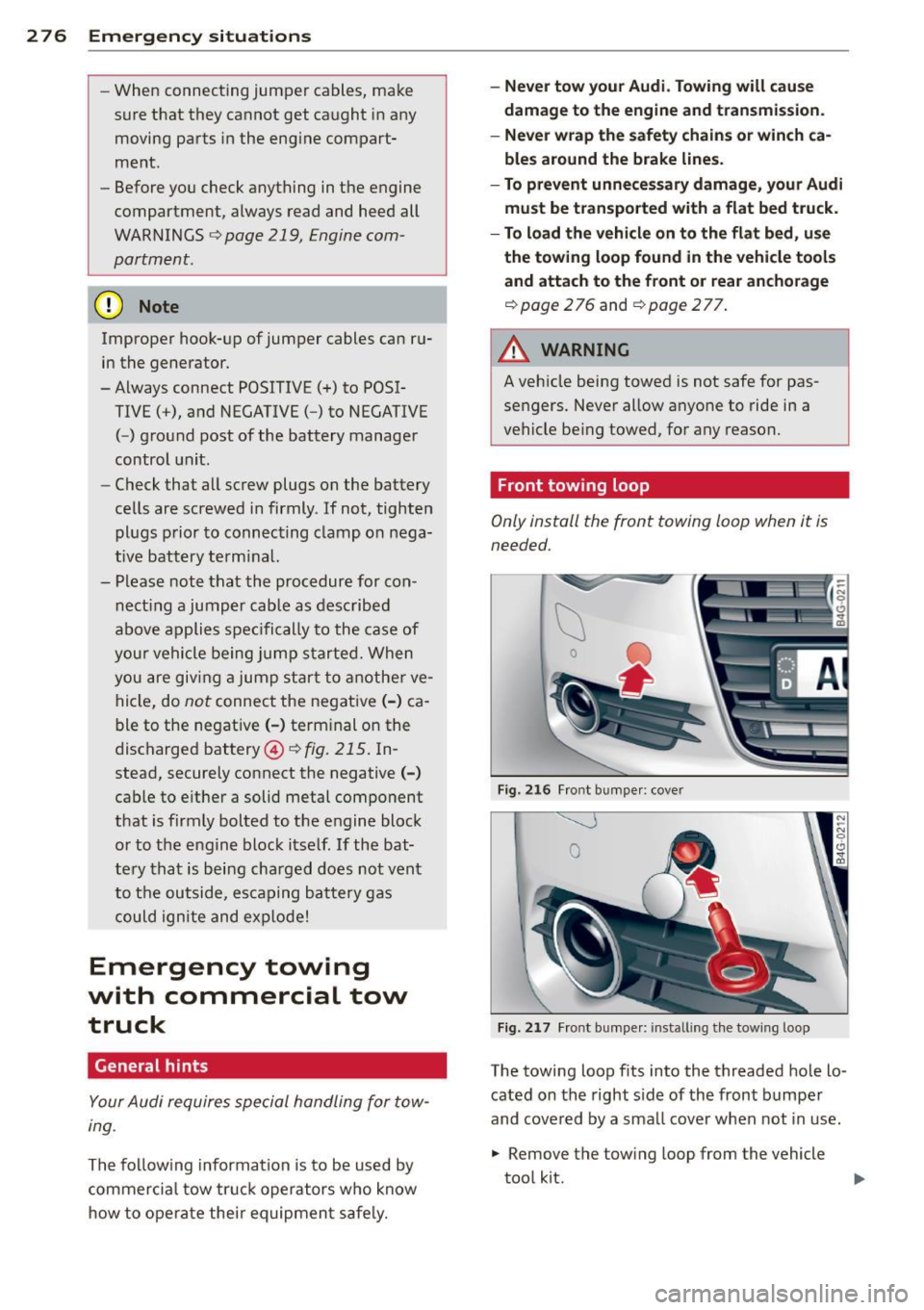
2 76 Emergency situations
-When connecting jumper cables, make
sure that they cannot get caught in any
moving parts in the engine compart
ment.
- Before you check anything in the engine
compartment, always read and heed all
WARNINGS c:>
page 219, Engine com
partment.
(D Note
Improper hook-up of jumper cables can ru
in the generator.
-Always connect POSITIVE(+) to POSI TIVE(+), and NEGATIVE( -) to NEGATIVE
( - ) ground post of the battery manager
control unit.
- Check that all screw plugs on the battery
cells are screwed in firmly . If not, tighten
plugs prior to connecting clamp on nega
tive battery terminal.
- Please note that the procedure for con
necting a jumper cable as described
above applies specifically to the case of
you r vehicle being jump started. When
you are giving a jump start to another ve
hicle, do
not connect the negative(-) ca
ble to the negative(-) terminal on the
discharged battery@c:>fig.
215. In
stead, securely connect the negative(-)
cable to either a solid metal component
that is firmly bolted to the engine block
or to the engine block itself. If the bat
te ry that is being charged does not vent
to the outside, escaping battery gas
could ignite and explode!
Emergency towing
with commercial tow
truck
General hints
Your Audi requires special handling for tow
tng.
The follow ing information is to be used by
commercia l tow truck operators who know
how to operate their equipment safely.
-Never tow your Audi. Towing will cause
damage to the engine and transmission .
- Never wrap the safety chains or winch ca
bles around the brake lines.
- To prevent unne cessary damage , your Audi
must be transported with a flat bed truck.
- To load the vehicle on to the flat bed, use
the towing loop found in the vehicle tools
and attach to the front or rear anchorage
c:> page 2 76 and c:> page 2 77.
.&_ WARNING
=
A vehicle being towed is not safe for pas-
sengers. Never allow anyone to ride in a
vehicle be ing towed, for any reason.
Front towing loop
Only install the front towing loop when it is
needed.
Fig. 216 Front bumpe r: cove r
Fig. 217 Front bumper: installing the towing loop
-
The towing loop fits into the threaded hole lo
cated on the right side of the front bumper
and covered by a sma ll cover when not in use.
.,. Remove the towing loop from the vehicle
tool kit.
Page 281 of 306
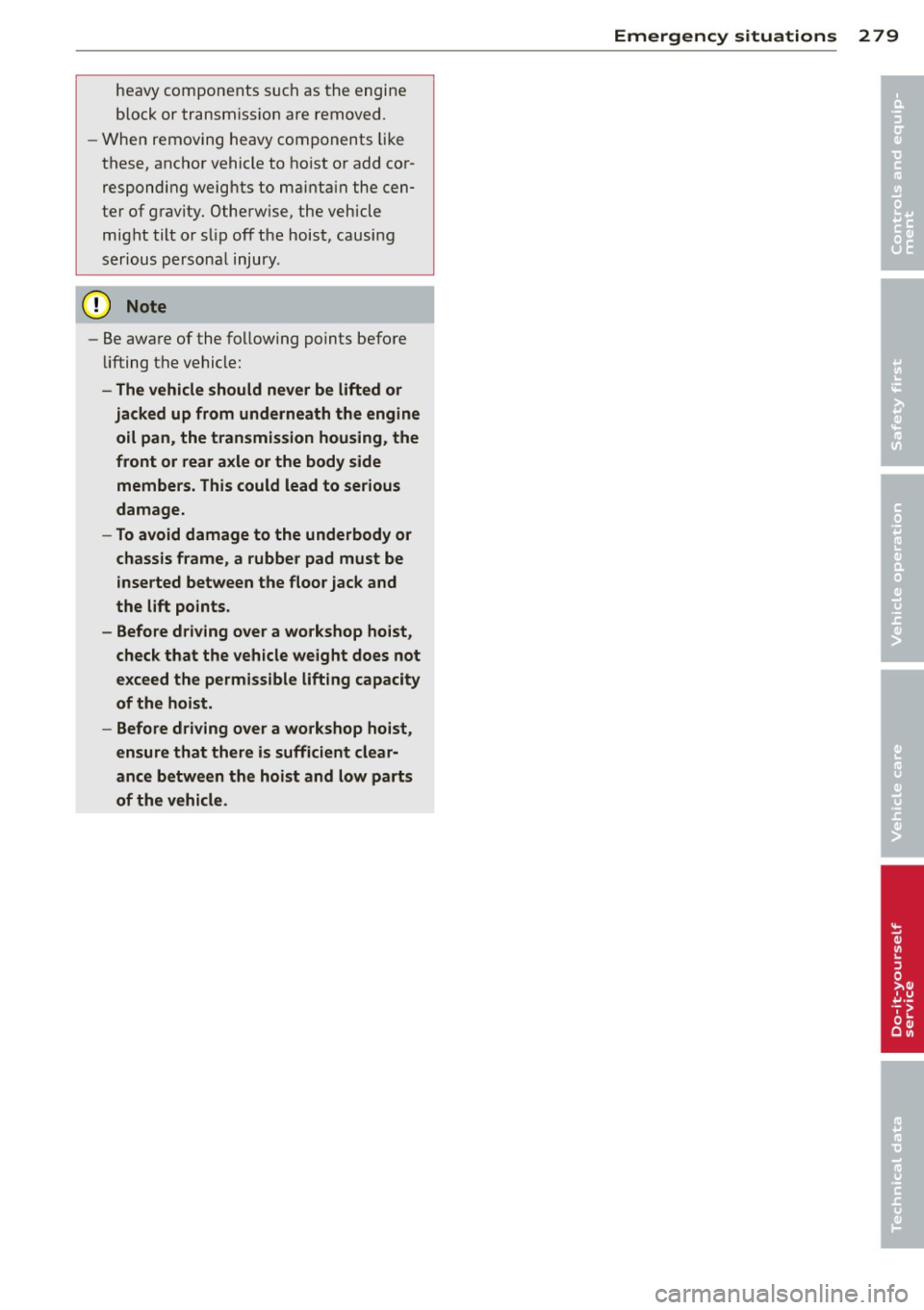
heavy components such as the engi ne
b lock or transmiss ion are removed.
- W hen removing heavy components like
these, ancho r vehicle to hoist o r add cor
respond ing weig hts to ma inta in the cen
ter of g ravity . Otherwise, the vehicle
m ight tilt o r sli p off the hoist, causi ng
ser ious p erso na l in ju ry.
([) Note
-Be awa re of the fo llowing points befo re
li fting t he vehicle:
- The vehicle should never be lifted or
jacked up from underneath the engine oil pan, the transmission housing, the
front or rear axle or the body side
members. This could lead to serious
damage.
- To avoid damage to the underbody or
chassis frame , a rubber pad must be
i nserted between the floor jack and
the lift points.
- Before driving over a workshop hoist,
check that the veh icle weight does not
exceed the permissible lifting capacity
of the hoist.
- Before driving over a workshop hoist,
ensure that there is sufficient clear
ance between the hoist and low parts
of the vehicle.
Emergency situations 2 79
•
•
Page 288 of 306
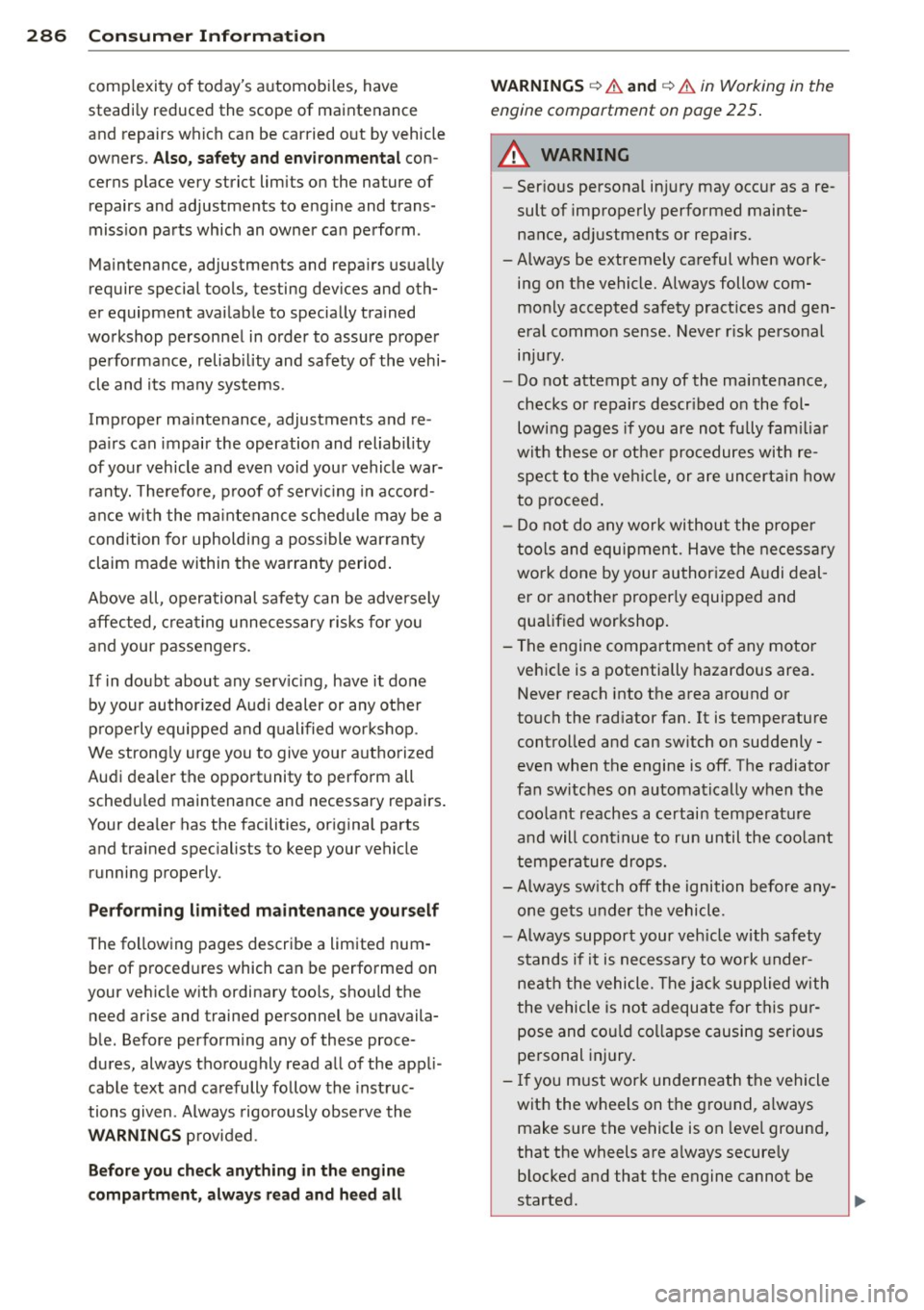
28 6 Con sum er Inf ormation
comp lexity of today's automobi les, have
steadi ly reduced the scope of maintenance
and repairs which can be carried out by vehicle
owners.
Also, s afety an d e nvir onm ent al con
cerns place very strict limits on the nature of repairs and adjustments to engine and trans
miss ion pa rts which an owner can perform .
Maintenance, adjustments and repa irs usua lly
require special tools, testing devices and oth
er equipment avai lab le to specially trained
workshop personnel in order to assure proper
performance, reliab ility and safety of the vehi
cle and its many systems .
Improper ma intenance, adjustments and re
pa irs can impair the operation and reliab ility
of your vehicle and even void your vehicle war ranty. Therefo re , proof of servici ng in accord
ance w it h the ma intenance sched ule may be a
condition for upholding a possible warranty
claim made within the warran ty period.
Above all, operational safety can be adve rsely
affected, creating unnecessary risks for you
and your passengers.
If in doubt about any serv icing, have it done
by your author ized Audi dealer or any other
p roperly equipped and qualified workshop .
We strong ly urge you to give your authorized
Audi dealer the opportunity to perform all
schedu led maintenance and necessary repairs .
Your dea ler has the facilities, or iginal parts
and tra ined spec ialists to keep your vehicle
running properly .
Performing lim it e d m aint en anc e y ourself
The fo llowing pages describe a limited num
ber of procedures which can be performed on
you r vehicle with ordinary too ls, shou ld the
need arise and trained personnel be unavaila
ble. Before performing any of these proce
dures, always thoroughly read all of the app li
cable text and ca refully follow the instruc
tions given. Always rigorously obse rve the
WARNINGS p rovided .
Before you ch eck anything in th e engin e
compartme nt, alway s read an d heed all WARNINGS
¢ & a
nd ¢ & in Working in the
engine comportment on page 225 .
A WARNING
--Serious personal in jury may occur as a re-
sult of improperly performed mainte nance, adjustments or repa irs.
- Always be extremely careful when work
ing on the vehicle. Always follow com
monly accepted safety pract ices and gen
eral common sense. Never r isk personal
in jur y.
- Do not attempt any of the maintenance,
checks or repairs descr ibed o n the fol
lowing pages if you are not fu lly fam iliar
with these or other procedures with re spect to the vehi cle, or are uncerta in how
to proceed .
- Do not do any work withou t the proper
too ls and equipment . Have the necessary
work done by your authorized A udi deal
er or anothe r properly equipped and
qualified workshop.
- The engine compar tment o f any motor
vehicle is a potentially hazardous area. Never reach into the area around or
touch the rad iator fan. It is temperature
control led and can sw itch on suddenly -
even when the engine is off . The radiator
fan switches on automatically when the
coo lant reaches a ce rtain temperature
and will cont inue to ru n until the coo lant
tempera ture drops.
- Always sw itch off the ignition before any
one gets under the vehicle.
- Always support your veh icle with safety
s tands if it is necessary to work under
neath the vehicle. The j ack s upp lied with
the vehicle is not adequate for this pur
pose and cou ld co llapse causing serio us
pe rsonal injury .
- If you must work underneath the vehicle
with the wheels on the ground, a lways
make sure the vehicle is on leve l ground,
that the wheels are a lways secure ly
blocked and that t he engine cannot be
started .
Page 289 of 306
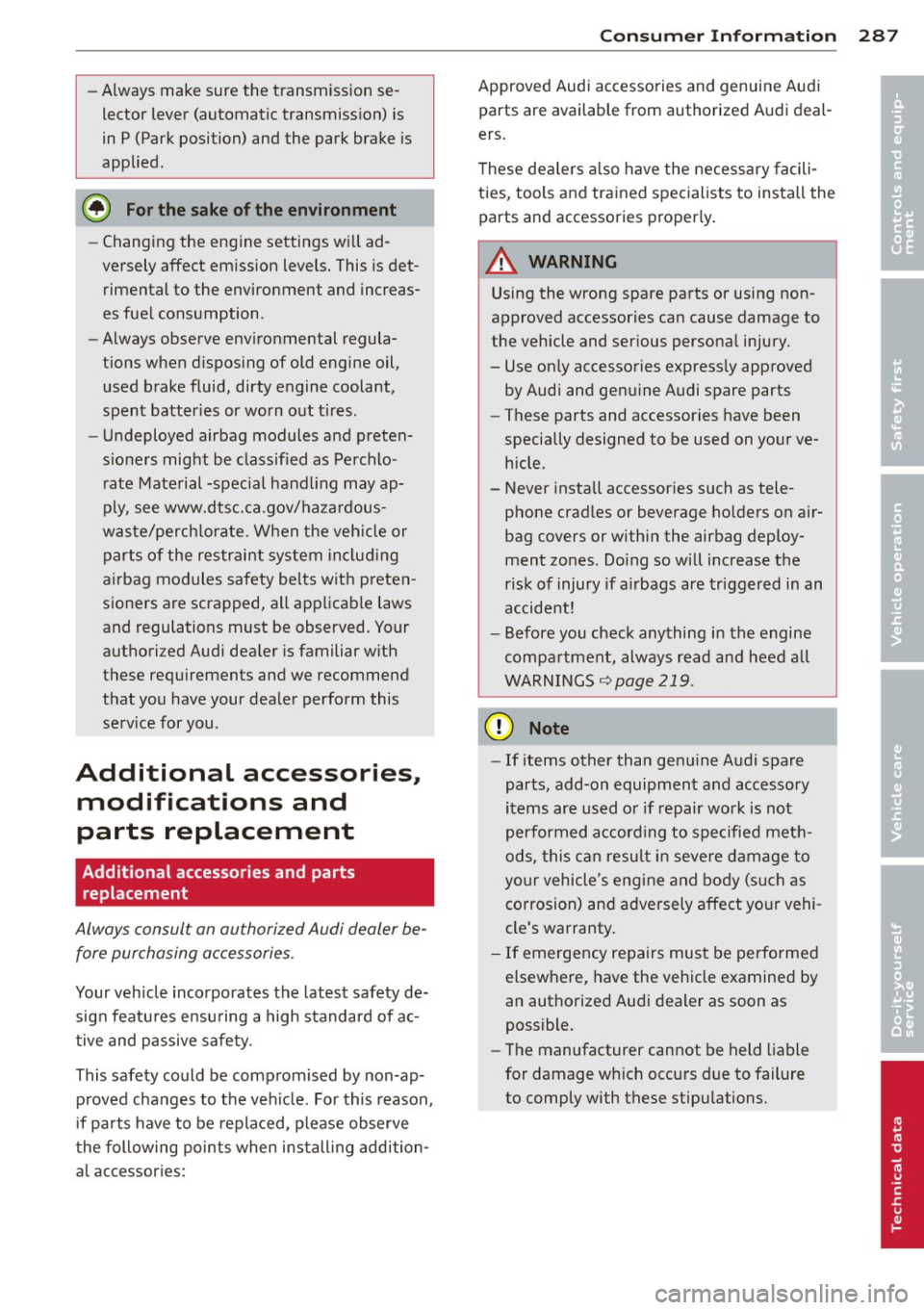
-Always make sure the transm ission se
lector lever (automatic transmiss ion) is
in P (Park position) and the park brake is
applied.
@) For the sake of the environment
- Changing the eng ine settings w ill ad
versely affect em ission levels. This is det
rimental to the environment and increas
es fuel consumption .
- Always observe env ironmental regula
tions when d isposing of old engine oil,
used brake fluid, dirty engine coolant,
spent batter ies or worn out t ires.
- Undeployed airbag modules and preten
s ioners might be classified as Perchlo
rate Material -specia l hand ling may ap
ply, see www.dts c.ca .gov/hazardous
waste/perch lorate. When the veh icle or
parts of the restraint system includ ing
airbag modules safety belts wit h preten
sioners are scrapped, all applicable laws
and regulations must be observed. Your
a uthorized Audi dea ler is familiar w ith
these requirements and we recommend
that you have your dea ler perform this
serv ice for you .
Additional accessories,
modifications and
parts replacement
Additional accessories and parts
replacement
Always consult an authorized Audi dealer be
fore purchasing accessories.
Your veh icle incorporates the latest safety de
sig n featu res ensu ring a high standard of ac
tive and passive safety.
This safety could be compromised by non-ap proved changes to the veh icle. For this reason,
if parts have to be replaced, please observe
the following points when install ing addition
a l accessories:
Con sumer In formation 287
Approved Audi accesso ries and genuine Audi
parts are available from authorized Audi deal
ers.
T hese dea lers a lso have the necessary facili
ties, tools and trained specialists to install the
parts and accessories proper ly.
A WARNING
Using the wrong spare parts or using non
approved accessories can cause damage to
the vehicle and serious persona l injury.
- Use on ly accessories express ly approved
by Audi and genu ine Audi spare parts
- These parts and accessories have been
specially designed to be used on your ve
hicle .
- Never install accessories such as tele
phone cradles or beverage holders on air
bag covers or within the airbag deploy
ment zones . Do ing so will increase the
risk of injury if a irbags are triggered in an
accident!
- Before you check anything in the engine
compa rtment, always read and heed all
WARNINGS
r:::;. page 219.
(D Note
-If items other than genuine Audi spare
parts, add-on equipment and accessory
items are used or if repair work is not
performed accord ing to spe cified meth
ods, this can result in severe damage to
yo ur vehicle's engine and body (such as
corrosion) and adversely affect your vehi
cle's warranty .
- If emergency repairs must be performed
elsewhere, have the vehicle examined by
an authorized Audi dealer as soon as
possible.
- The manufacturer cannot be held liable
for damage wh ich occurs due to failure
to comply with these stipulations.
•
•
Page 294 of 306

292 Index
Checking Engine coolant level ................ 232
Tire pressure . ............. ... .... . 246
Ch ild restra ints
Danger of using child restra ints in the
front seat . . . . . . . . . . . . . . . . . . . . . . . . 147
Where can I get additional information
about child restraints and their use? .. 189
Child restraint system anchors ... .... . 185
Child safety .. .. . .......... .. .. .... . 171
Convertible locking retractor .. .. .. .. . 182
Important safety instructions for us ing
chi ld safety seats ......... .. .. .... . 175
I mportant things to know when dr iving
with chi ldren . ............... .... . 171
Tether anchors ............ ... .... . 188
Tether straps ..................... 188
Child safety lock Rear doors .............. .. .. .... .. 38
Child safety seats .......... .... .... . 177
Booster seats . .......... ... .. .. ... 180
Convertible ch ild seats .... .. .. .. .. . 178
Convertible locking retractor .. .. .. ... 182
H ow do I proper ly install a child safety
seat in my vehicle? ...... .. .. .. .. .. . 175
I nfant seats .............. ... .... . 177
I nstalling . ............... ... .... . 182
Installing a child restraint using the
LATCH system ................ .... . 187
LATCH system ............ .... ..... 187
Lower anchorages ............ ..... 186
Mounting and releasing the anchorage
hook .. .. .. ... .... ...... ... ... .. . 187
Safety instructions . . . . . . . . . . . . . . . . . 17 5
Unused safety belts on the rear seat .. 177
Cigarette lighter . . . . . . . . . . . . . . . . . . . . . 56
C leaning
Head-up Display .............. .... . 215
Matte finish paint ............ .... . 210
C leaning and protection ..... .. .. .. .. . 208
A lcantara (synthet ic suede) .......... 218
Engine compartment ....... .... ... . 219
Exhaust tail pipes .......... ... .... . 214
Fabrics and fabric coverings .. .. ..... 215
Instrument panel ............. ..... 216
Interior . . . . . . . . . . . . . . . . . . . . . . . . . . 214
Leather . . . . . . . . . . . . . . . . . . . . . . . . . . 217
MMI display/controls .. ... ... .. .. ... 214 Plastic
and vinyl . .............. .... 212
Plastic parts . . . . . . . . . . . . . . . . . . . . . . 216
Safety be lts ... .. ................ . 218
trim strips ................... .... 212
Trim strips ................... .... 212
Cleaning the Head-up Display ......... 215
Climate control Air vents . . . . . . . . . . . . . . . . . . . . . . . . . . 66
Climate controls . .. ............. .. .. . 64
Climate control (four-zone)
Operation ..... .. .. .............. .. 67
Climate control (three-zone) Operation . . . . . . . . . . . . . . . . . . . . . . . . . 65
Clock ...... .... .................... 27
Closing Sliding/tilting sunroof ............... 40
Cold tire inflation pressure ........ .. .. 244
Coming home ....................... 43
Compact spare tire ................. . 262
Compartments . . . . . . . . . . . . . . . . . . . . . . 57
Compliance ..... .. .. .............. . 288
Consumer Information . . . . . . . . . . 134, 285
Consumption (fuel) ............. .... . 24
Contacting NHTSA .............. .... 134
Convenience key . .. ... ........... ... . 35
Starting the engine ............ .... . 71
Stopping the engine (START ENGINE
STOP button) . . . . . . . . . . . . . . . . . . . . . . 73
Switching the ignition on ........ ... . 71
Unlocking and locking vehicle .... .. .. . 35
Convertib le child safety seats ..... .... 178
Convertible locking retractor Activating ... .. .. .. ..... ...... .. .. 184
Deact ivating . .. .. ... ....... ... .. .. 184
Using to secure a child safety seat 1.82, 184
Coolant
refer to Engine coolant ............. 232
Cooling mode (automatic climate control) 67
Cooling mode (climate control) . . . . . . . . . 65
Cruise contro l
Changing speed .. ............. .... . 80
Presetting your speed .............. . 80
Switching off . . . . . . . . . . . . . . . . . . . . . . 80
Switching on . . . . . . . . . . . . . . . . . . . . . . . 79
Warning/ind icator lights ........... .. 23
(upholder .. .... ............... ..... 57
Page 296 of 306
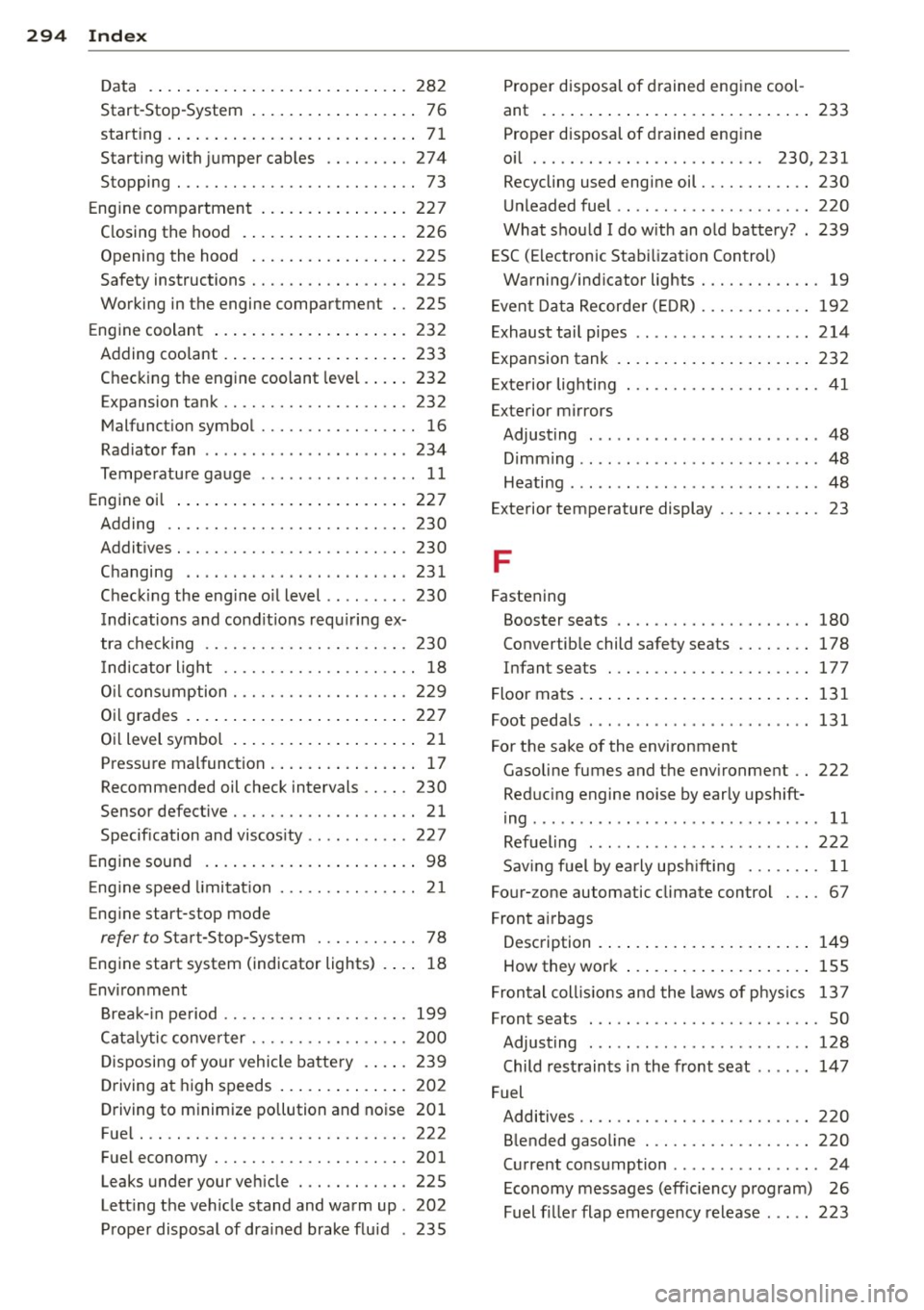
294 Index
------------------------------------
Data .... ....... ......... ... .... . 282
Start-Stop-System . . . . . . . . . . . . . . . . . . 76
start ing .. .. ................ ..... .. 71
Startingwithjumpercables .. .. ..... 274
Stopping . . . . . . . . . . . . . . . . . . . . . . . . . . 73
Engine compartment ........ .... ... . 227
C losing the hood .......... ... .... . 226
Opening the hood ................. 225
Safety instructions ........ .. .. .... . 225
Working in the engine compartment .. 225
Engine coolant .................... . 232
Adding coolant ............ ... .... . 233
Checking the engine coolant level .... . 232
Expansion tank ........... .. .. .. .. . 232
Malfunction symbol ....... .. .. .... .. 16
Radiator fan .............. ... .. .. . 234
Temperature gauge ........ ..... .. .. 11
Engine oil ... ................ ..... . 227
Adding .. .... ........... .... .... . 230
Additives . .. ............. .. .. .. ... 230
Changing .... ... .... .... .. .. .. .. . 231
Check ing the engine oil level .. .. .. .. . 230
I ndications and cond it ions requ iring ex-
tra checking .. ........... .. .. .... . 230
I ndicator light ........... .. .. .. .. .. 18
O il consumption .......... .... .... . 229
Oil grades . ................. ..... . 227
Oil level symbol .................... 21
Pressure malfunction ....... ... .. .. .. 17
Recommended oil check intervals ..... 230
Sensor defective . . . . . . . . . . . . . . . . . . . . 21
Specification and viscosity .. .. .. .. .. . 227
Engine sound .............. ... .... .. 98
E ng ine speed limitation ....... .. .. .. . . 21
Engine start-stop mode
refer to Star t-Stop-System ... .. .. .. .. 78
Engine start system (indicator lights) . ... 18
Environment Break-in period ......... .. .. .. .. .. . 199
Cata lytic converter ........ .. .. .. .. . 200
Disposing of your vehicle battery . ... . 239
Driving at high speeds .............. 202
Driving to minimize pollution and noise 201
Fuel . .. .. ............... .. .. .... . 222
Fuel economy ............ .... .... . 201
Leaks under your vehicle ... .. .. .. .. . 225
Lett ing the vehicle stand and warm up . 202
Proper disposal of drained brake fluid . 235 Proper disposal of d
rained engine cool-
ant ..... ..... .. .. .............. . 233
Proper disposal of drained eng ine
oil . . . . . . . . . . . . . . . . . . . . . . . . . 230,231
Recycling used engine oil ........ .... 230
Unleaded fuel .. .. ................ . 220
What should I do with an old battery? . 239
ESC (Electronic Stabilization Control) Warning/indicator lights ........ .. .. . 19
Event Data Recorder (EDR) ........ .. .. 192
Exhaust tail pipes .. .......... ...... . 214
Expansion tank .... ................ . 232
Exterior lighting . ... ............ .. .. . 41
Exterior mirrors Adjusting ..... .. .. ........ ...... .. 48
Dimming .. .. .. .. .. ..... ...... .. .. . 48
Heating ...... ... .. .............. .. 48
Exterior temperature display ...... .. .. . 23
F
Fastening
Booster seats . . . . . . . . . . . . . . . . . . . . . 180
Convertible child safety seats . . . . . . . . 178
Infant seats ... .. ............. .... 177
Floor mats . ..... .. ................ . 131
Foot pedals ..... .. ..... ........... . 131
For the sake of the environment Gasoline fumes and the environment .. 222
Reducing engine noise by early upshift-
ing ...... .... ... .. ................ 11
Refueling ... .. .. ....... ...... .. .. 222
Sav ing fuel by early upsh ifting . .. .. .. . 11
Four- zone automatic climate control . .. . 67
Front airbags
Description .... .. ................ . 149
How they work ... ................ . 155
Frontal coll is ions and the laws of phys ics 137
Front seats . . . . . . . . . . . . . . . . . . . . . . . . . 50
Adjusting ... .. .. ....... ...... .. .. 128
Child restraints in the front seat ...... 147
Fuel Additives .. .... .. ............. .... 220
Blended gasoline .............. .... 220
Current consumption .............. .. 24
Economy messages (efficiency program) 26
Fuel filler flap emergency release ... .. 223
Page 297 of 306
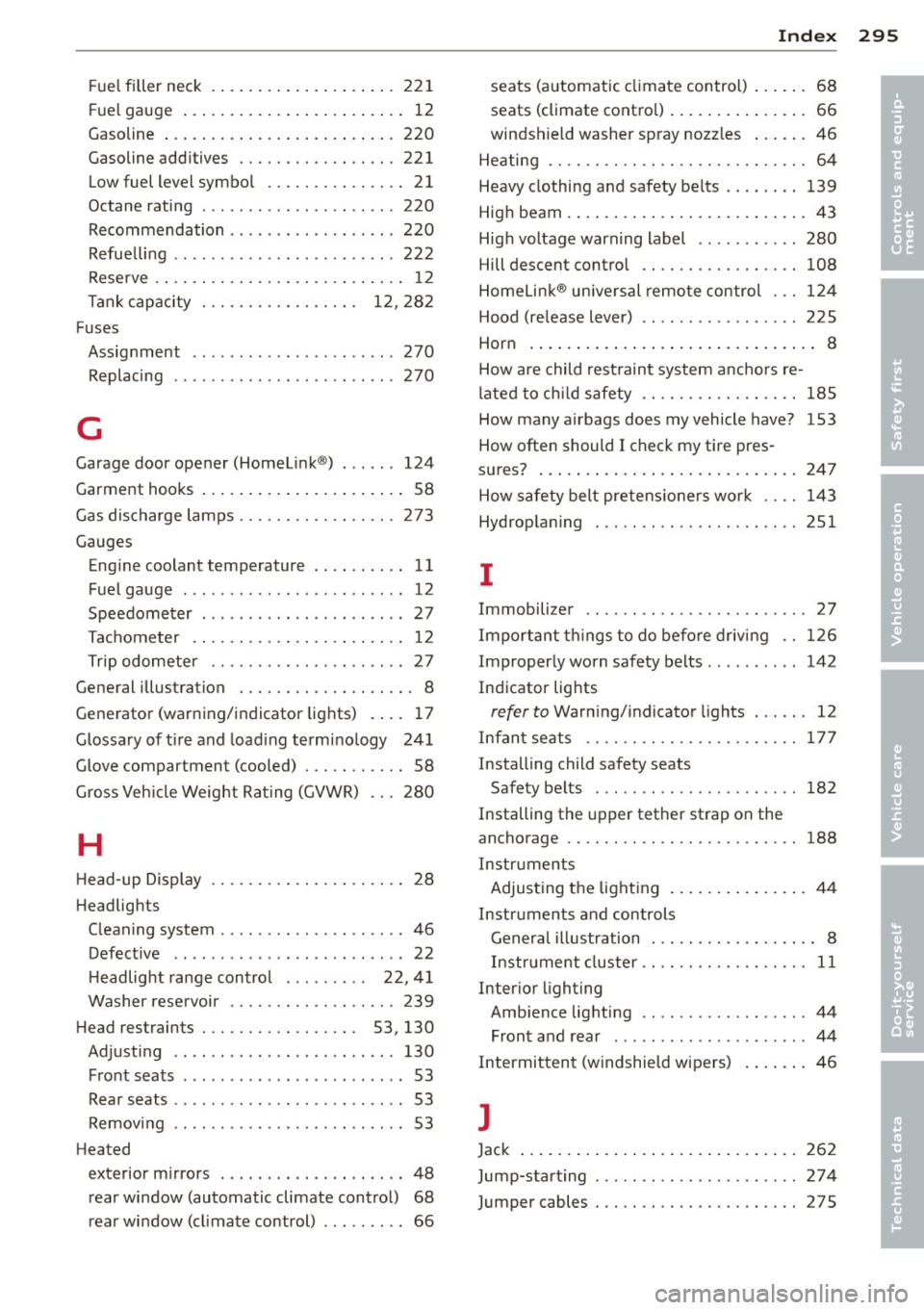
Fuel filler neck ................ .... 221
Fuel gauge ................. ... .... 12
Gasoline ... ................ ... .. . 220
Gasoline additives ........ .. .. .. .. . 221
Low fuel level symbol . . . . . . . . . . . . . . . 21
Octane rating ............... ... ... 220
Recommendation .... ..... .. .. .. .. . 220
Refuelling ............ ...... .... .. 222
Reserve .. .. ............. .. .. .. .. .. 12
Tank capacity . . . . . . . . . . . . . . . . . 12, 282
Fuses Assignment ..... .. ...... .. .. .. .. . 270
Replacing .. ................ ... ... 270
G
Garage door opener (Homelink ®) . ... .. 124
Garment hooks . . . . . . . . . . . . . . . . . . . . . . 58
Gas discharge lamps ........ .. .. .. .. . 273
Gauges Engine coolant temperature .. .. .. ... . 11
Fuel gauge . .. .............. ... ... . 12
Speedometer . ........ .... ... ... ... 27
Tachometer . . . . . . . . . . . . . . . . . . . . . . . 12
Trip odometer ........... .. .. .. .. .. 27
General illustration . ....... .. .. .. .. ... 8
Generator (warning/indicator lights) . ... 17
Glossary of tire and loading terminology 241
Glove compartment (cooled) . .. .. .. .. .. 58
Gross Vehicle Weight Rating (GVWR) .. . 280
H
Head -up Display . . . . . . . . . . . . . . . . . . . . . 28
Headlights Cleaning system . .......... ... ... ... 46
Defective . . . . . . . . . . . . . . . . . . . . . . . . . 22
Headlight range control . . . . . . . . . 22, 41
Washer reservoir ......... .. .. .. .. . 239
Head restraints . . . . . . . . . . . . . . . . . 53, 130
Adjusting .. .. ... .. ... ... .. .. .. .. . 130
Front seats . . . . . . . . . . . . . . . . . . . . . . . . 53
Rear seats . . . . . . . . . . . . . . . . . . . . . . . . . 53
Removing .. .... ......... .... .. .. .. 53
Heated exterior mirrors . ...... ... .. .. .. .. .. 48
rear window (automatic climate control) 68
rear window (climate control) . .. ... ... 66
Index 295
seats (automatic climate control) ...... 68
seats (climate control) . . . . . . . . . . . . . . . 66
windshield washer spray nozzles ..... . 46
Heating .. .. .. .. .. .... ........... .. . 64
Heavy clothing and safety belts .. .. .. .. 139
High beam ... ..... .. ................ 43
High voltage warning label .......... . 280
Hill descent control ................. 108
Homelink ® universal remote control . .. 124
Hood (release lever) .. .. .. ...... .... . 225
Horn ....... ... .... .. .............. . 8
How are child restraint system anchors re-
lated to child safety .... ......... .. .. 185
How many airbags does my vehicle have? 153
How often should I check my tire pres-
sures? ............................ 247
How safety belt pretensioners work .. .. 143
Hydroplaning . .. .. .. .. ........... .. 251
I
Immobilizer .. .. ...... ............. . 27
Important things to do before driving .. 126
Improperly worn safety belts .......... 142
Indicator lights
refer to Warning/indicator lights ... .. . 12
Infant seats .. .. ...... ........... .. 177
Installing child safety seats Safety belts . . . . . . . . . . . . . . . . . . . . . . 182
Installing the upper tether strap on the
anchorage .. .... .. .. . .............. 188
Instruments Adjusting the lighting ............... 44
Instruments and controls General illustration . . . . . . . . . . . . . . . . . . 8
Instrument cluster . . . . . . . . . . . . . . . . . . 11
Interior lighting Ambience lighting .. .. .. ...... .... .. 44
Front and rear ... .. .. .. ...... .... .. 44
Intermittent (windshield wipers) .... .. . 46
J
Jack ........ ... .... ............... 262
Jump-starting . .. .... .. .. ...... .... . 274
Jumper cables . .. .. ................. 275
•
•